Kitesurfing has grown in popularity over the last years and is now becoming more accessible to disabled people, but of course, that requires more efforts, investment in equipment and special training. It is surely very rewarding for all people who experience a great change in their life. We have surveyed both instructors as well as disabled kitesurfers to find out how the sport has been possible for them and how they feel about it.
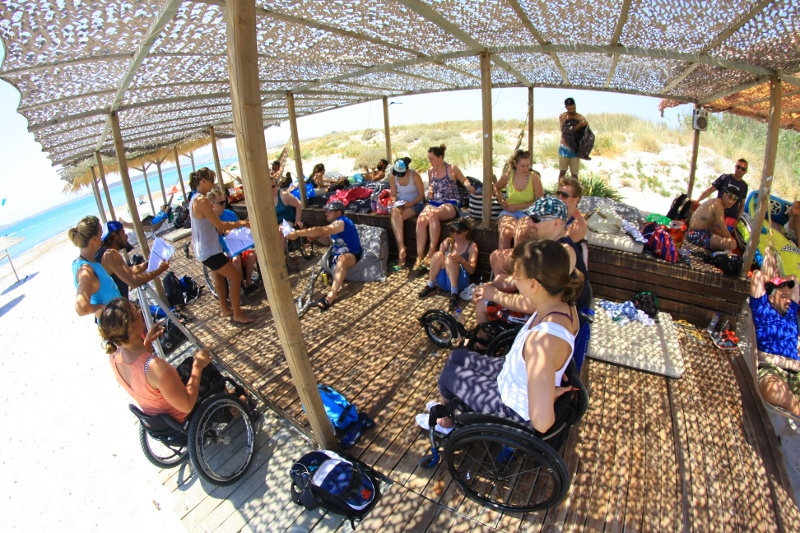
How Do Kite Centers Adapt to Teach Disabled People
Some kite schools equipped to teach people with disabilities use the special seat invented by Christophe Martin designed especially for handiriders, which costs over 3000 euros. Some have adapted and modified the equipment they already use such as wide windsurfing boards. Others use inflatable chairs or catamarans powered by a kite. Kite schools spend on average, around 400 to 4000 euros over a period of 3 years in special teaching equipment to accommodate their students with disabilities to teach them safely. “Also there are many costs that cannot be calculated as there are great modifications required as there is no industry standards,” explains Instructor Andreas Alamanos.
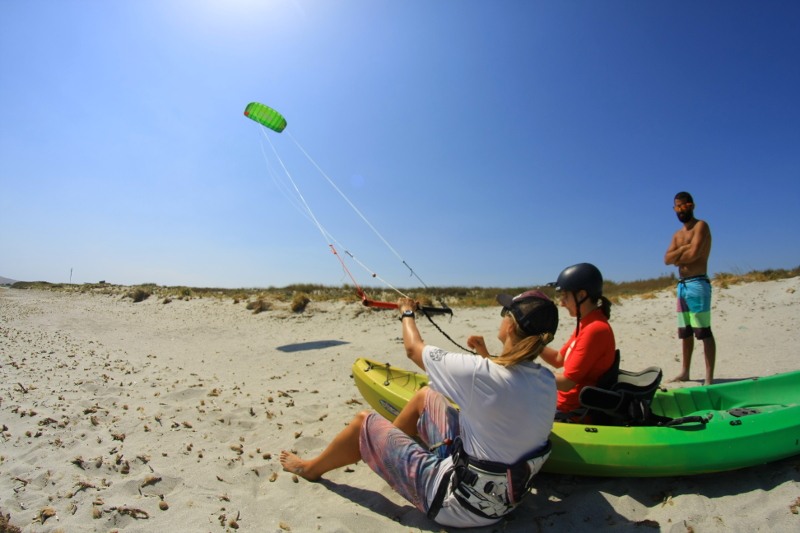
In addition, small kites with short lines are becoming more widely used to teach the first steps of kiteboarding. “We use a tandem harness for the lessons in the water and a wheelchair trainer kite sessions for land,” adds Glen Baker who has been teaching snowboarding and kitesurfing to disabled for more than 16 years.
To teach in the water, some instructors use a Flysurfer Boost that is a highly efficient L.E.I kite used in races. It has proven to be very stable in all types of wind and effortless in low wind. That probably explains why instructors who teach disabled people often use it, as it can easily take both the weight of the rider as well as the special board or seat used. It is also very easy to maneuver and re-launch. Some instructors use it with a Praschberger seat.
Originally, the Praschberger seat (fixed on a mono ski) was designed by paraplegic Alois Spraschberger himself, who after his accident, had the ‘desire of movement and joy of life’ and hit the ski slopes again! The seat has an easy quick release for drag lifts on both sides and has a special spring and shock absorption system and foot fairing.
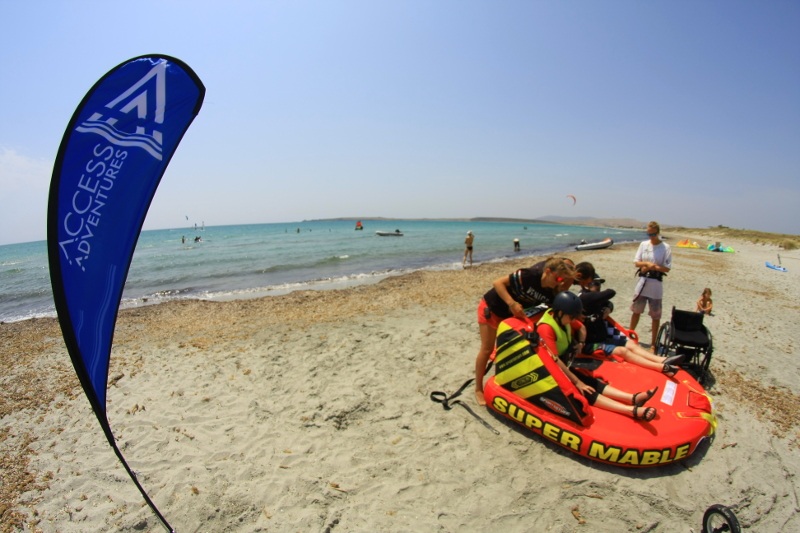
Paraplegic and kitesurfer Christophe Martin created, with the same objective in mind as Spraschberger, to practice his favorite sports, among them, kitesurfing. After a few prototypes, a new seat was realized with the support of both associations O’Také and Vagdespoir that promotes the kitesurfing for disabled people. The new 100%-framed seat is modular and can be fixed on all types of boards enabling disabled people to ride, surf and jump just like any other kiteboarders!
Using the new technology on the market and modifying equipment to teach disabled people is not all when it comes to live lessons. Staff in kite centers need special training. To do so, many centers invite professionals to hold seminars on different types of disabilities and special assistance for to their students.
Some schools Like Surf Club Keros in Greece have also invited Christophe Martin’s team to come train their staff on how to use the special seat for teaching kitesurfing. Seminars on disabilities in other centers also include a section on methodology and the implementation of the IKO standards.
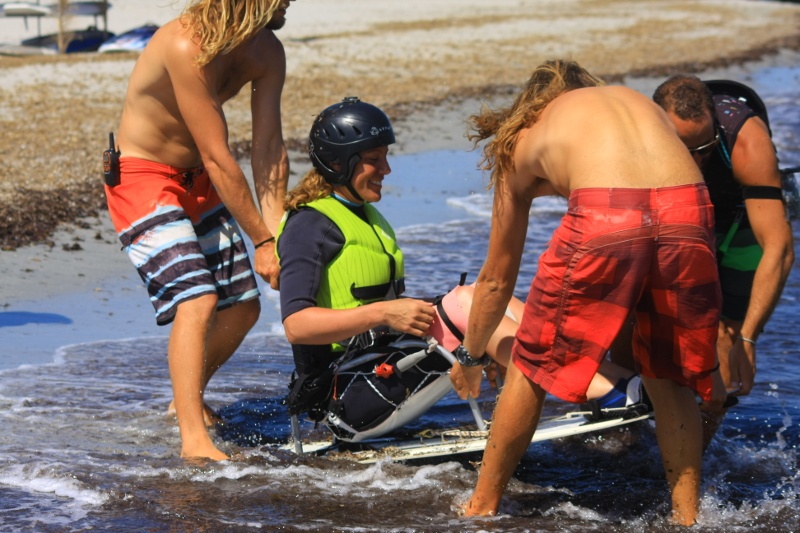
Challenges and Rewards from Teaching Disabled Students
All instructors and staff interviewed agree to say that although it is a challenge to teach disabled persons, the reward is great. “It was a wonderful smile in all their faces. That was the best satisfaction ever. The smile in their faces but also the smile on their parents or partners' faces,” exclaims Sara Salmaso.
Instructors have to find new ways of teaching to overcome the challenge the disability of their students creates and find the right equipment keeping in mind the safety of the students. Instructors focus on ‘a building-block method while trying to make the lessons fun too at the same time’ to motivate the students. As they need to be creative to make sure they can suit each student’s specific need, ensure their safety, consider their handicap and make them enjoy the sport, “You become a better instructor but most of all a better person,” says Ioannis Doumtsios.
The First Steps into Kiteboarding
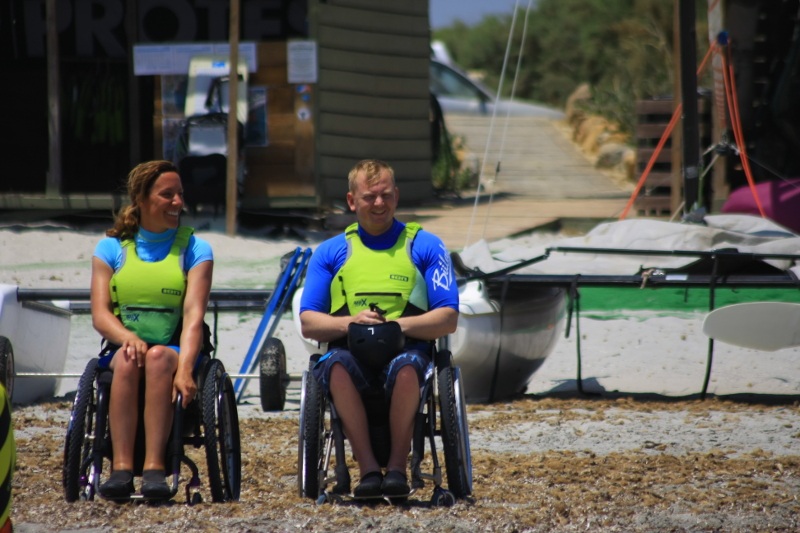
All kitesurfing students interviewed were aged between 27 and 45 years old, and they got into kitesurfing 2 to 8 years ago. Their disabilities mainly consisted of paraplegia, double amputation and incomplete spinal cord injury affecting movement.
People with disabilities are all on the same page: Learning kitesurfing is very hard, and they face many obstacles such as adapting or customizing the equipment depending on their disability. Rider Louise Johansson indicates, “Handle the kite on land was pretty easy but the water sessions were harder.” Disabled people who want to start kiteboarding have to plan well and often need to call on professionals who can advise them on how to make their first steps as not all centers and countries provide proper facilities and training for them.
Jim Kolokithas explains, “I did some investigating and quickly realized no one in Australia was sit kiting, nor was there a school offering such a program to the disabled. After further research, I learnt of Chris Sal who is the highest trained and an IKO Examiner in the country. After months of trying to adapt equipment, source equipment etc. We faced many many obstacles and issues, but after many months of sheer determination and planning, we hit the water, mid-winter. Once we had all the equipment good enough to actually hit the water, it was very achievable!”
How has Kitesurfing Changed their Life
Most disabled kiters share the common idea that the sport brought a lot to their life! “The sport didn't change my life, but it did inspire me as another challenge to get right,” says Michael Stevens. Jim Kolokithas adds, “My disability no longer existed, and I was on the same level as any other novice taking on kiteboarding. For us though, we simply try to get back into the swing of life as quickly and satisfyingly as possible.”
Most of them were inspired by Christophe Martin, Thierry Schmitter, disabled sailor, Nicholas Lanquetin, paraplegic kitesurfer and from disabled athletes in general. The students are extremely thankful for learning the sport. The time they spend on the water is the time they do not need their wheelchair, and they can feel like anybody else. Just like any other person learning kiteboarding, they are thrilled, excited, and challenged. Although they feel it takes tremendous efforts, many are still kitesurfing today and encourage other disabled people to get into the sport too. “This sport changed my life and actually is the best therapy I know for my problem,” says Alessandro Sassi.
Kiteboarding has proven to be the best option for disabled people to retrieve a sense of life and inspiration in the future. For instructors, though challenging, it is an extremely positive and rewarding experience to be able in a way, to give disabled people a sense of mobility again!
We would like to acknowledge and thank the following instructors: Rick Krystallis (IKO School owner of Surf Club Keros and IKO Instructors at Keros Island, Greece), Andreas Alamanos and Joannis Doumtsios - (Keros Island, Greece), Dirk Hückstädt (Germany), Glen Baker (Canada), Sara Salmaso (Tarifa, Spain) and Charles Joel Ludovic Bertrand (IKO Instructor at Le Morne, Mauritius),
Many thanks as well to disabled kiteboarders Jim Kolokthas (Australia), Markus Pfisterer (Switzerland), Louise Johansson (Sweden), Stevens (South Africa), Makis Kalaras (IKO Member, Greece) and Alessandro Sassi (Italy) for taking part in this survey and sharing their experience and inspirational stories about learning kitesurfing!
